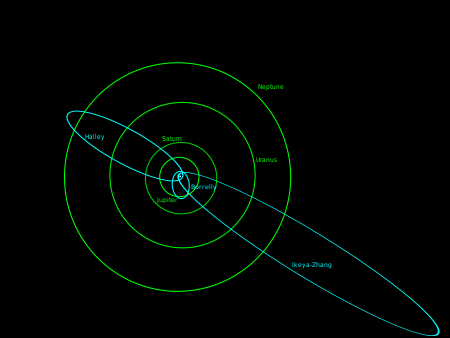153P/Ikeya–Zhang
 Ikeya–Zhang on April 1, 2002
| |
| Discovery | |
|---|---|
| Discovered by | Kaoru Ikeya, Zhang Daqing |
| Discovery date | February 1, 2002 |
| Designations | |
| C/2002 C1, C/1661 C1 | |
| Orbital characteristics | |
| Epoch | October 13, 2002 |
| Aphelion | 101.92 AU |
| Perihelion | 0.50714 AU |
| Semi-major axis | 51.213 AU |
| Eccentricity | 0.99009 |
| Orbital period | 366.51 yr |
| Max. orbital speed | 59 km/s (2002) |
| Min. orbital speed | 0.29 km/s (2182-Nov-24) |
| Inclination | 28.119° |
| Last perihelion | March 18, 2002 January 29, 1661 |
| Next perihelion | September 1, 2362 2363-Mar-14 |
Comet Ikeya–Zhang (Japanese, Chinese: 池谷-張彗星, officially designated 153P/Ikeya–Zhang) is a comet discovered independently by two astronomers from Japan and China in 2002. It has by far the longest orbital period of the numbered periodic comets. It was last observed in October 2002 when it was about 3.3 AU (490 million km) from the Sun.
On February 1, 2002, Chinese astronomer Zhang Daqing from Kaifeng discovered a new comet in the constellation Cetus, and reported it to the IAU. He found that Japanese astronomer Kaoru Ikeya had discovered it earlier than he had, as the time of sunset is earlier than China. According to tradition, since they discovered the new comet independently, the comet was named after both of them. The comet was initially designated as C/2002 C1 (Ikeya–Zhang).
The comet was observed in 1661, 341 years earlier, by Polish astronomer Johannes Hevelius. A bright comet had also been recorded by Chinese astronomers in 1661.
The permanent designation "153P" was given to the comet. It has the longest known orbital period of any periodic comet (366.51 years). Its orbital speed around the Sun varies from 59 km/s at perihelion to 0.29 km/s at aphelion.
The comet passed perihelion on March 18, 2002, and with apparent magnitude 2.9. With a multi-hundred year orbit involving asymmetric outgassing the next perihelion passage is expected between 2362–2363. During March–April 2002, protons from the comet tail may have been detected by the Cassini spacecraft. This data suggested the comet tail had a length greater than 7.5 AU, making it the longest yet detected.
